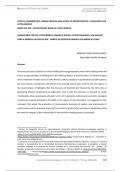Revista de Direito da Cidade vol. 12, nº 2. ISSN 2317-7721
DOI: 10.12957/rdc.2020.50557
CRITICAL COMMENTARY: URBAN GROWTH AND ACCESS TO OPPORTUNITIES: A CHALLENGE FOR
LATIN AMERICA
FROM THE ADC - DEVELOPMENT BANK OF LATIN AMERICA
COMENTÁRIO CRÍTICO: CRESCIMENTO URBANO E ACESSO A OPORTUNIDADES: UM DESAFIO
PARA A AMÉRICA LATINA DO ADC - BANCO DE DESENVOLVIMENTO DA AMÉRICA LATINA
Madisson Yojan Carmona Rojas1
Oscar Adán Castillo Oropeza2
Abstract
This essay discusses, based on a critical reading of the argumentative lines of the Urban growth and
Access to opportunities: a challenge for Latin America Report. In the first place, the technical logics
of the treatment of urban issues in Latin America, whose emphasis in quantitative variables ignores
the socio-spatial contradictions derived from the existing intense class conflicts over the region. In
the second place, it highlights that the discourse of development fostered by the ADC aims at
generating efficient institutional arrangements, that is why the attention is directed to create
“sustainable urban governance schemes” and not to generate political and economic strategies
intended to unequal distribution of wealth in the region. In the third place, it is suggested in this
comment, that under the protection of contemporary dynamics of capital, new instruments of
public policies which promote financing the market of ground and housing are legitimized, while
the need to integrate urban communities in the decision–making process is preached.
1
Doctor en Geografía (Línea de especialización: Geografía urbana) Profesor-investigador adscrito al
Departamento de Ciencias Sociales de la Universidad Pedagógica Nacional de Colombia, Colombia. ORCID:
https://orcid.org/0000-0002-2942-4689 Researchgate:
https://www.researchgate.net/profile/Madisson_Carmona_Rojas Ciudad actual: Bogotá D.C., Colombia. E-
mail: mycarmonar@gmail.com
2
Licenciado en Sociología de la Universidad Autónoma del Estado de México, Maestro y Doctor en Ciencias
Sociales y Humanidades de la Universidad Autónoma Metropolitana Cuajimalpa. Investigador a tiempo
completo asignado a la División de Ciencias Sociales de la Universidad Intercultural del Estado de
Hidalgo. Universidad Intercultural del Estado de Hidalgo – México. ORCID iD: http://orcid.org/0000-0002-
3054-7993 Researchgatehttps://www.researchgate.net/profile/Oscar_Oropeza E-mail:
oscaradan68@gmail.com
Revista de Direito da Cidade, vol. 12, nº 2. ISSN 2317-7721. pp. 1534-1548 1534
, Revista de Direito da Cidade vol. 12, nº 2. ISSN 2317-7721
DOI: 10.12957/rdc.2020.50557
Keywords: Bank of Development of Latin America, Urban growth, Socio-spatial contradictions, Class
conflicts, Development, Metropolitan governance.
Resumo
Este ensaio discute, com base em uma leitura crítica das linhas argumentativas do crescimento
urbano e acesso a oportunidades: um desafio para o Relatório da América Latina. Em primeiro lugar,
a lógica técnica do tratamento de questões urbanas na América Latina, cuja ênfase nas variáveis
quantitativas ignora as contradições socioespaciais derivadas dos intensos conflitos de classe
existentes na região. Em segundo lugar, destaca que o discurso do desenvolvimento promovido
pela ADC visa gerar arranjos institucionais eficientes, por isso a atenção é direcionada para criar
“esquemas de governança urbana sustentável” e não para gerar estratégias políticas e econômicas
destinadas à distribuição desigual de riqueza na região. Em terceiro lugar, sugere-se neste
comentário que, sob a proteção da dinâmica contemporânea do capital, sejam legitimados novos
instrumentos de políticas públicas que promovam o financiamento do mercado de solo e habitação,
enquanto a necessidade de integrar as comunidades urbanas na decisão - processo de fabricação é
pregado.
Palavras-chave: Banco de Desenvolvimento da América Latina, Crescimento urbano, Contradições
socioespaciais, Conflitos de classe, Desenvolvimento, Governança metropolitana.
Introduction
In the late 1960‘s, the ‘Corporación Andina de Fomento’ – CAF (Andean Development
Corporation), henceforth ADC, was founded as an initiative from the Andean Community of Nations
(ACN) for the management of projects on infrastructure in the member nations: Venezuela,
Colombia, Perú and Bolivia. Later on, the service portfolio and the ADC outreach were enlarged to
take care of clients who were located beyond the borders of the Andean countries. In the year 2010,
the ADC became the Bank of Development of Latin America, in a period where the Bank of the
South, promoted by the so-called progressive governments of South America, was regarded as a
financial alternative before the traditional multilateral institutions (Inter-American Development
Bank (IDB), World Bank (WB) and International Monetary Fund (IMF)). In that sense, the main aim
of the ADC-Bank of Development of Latin America is to foster a “a sustainable development
approach by means of credit operations, non-refundable resources and support in technical and
Revista de Direito da Cidade, vol. 12, nº 2. ISSN 2317-7721. pp. 1534-1548 1535




